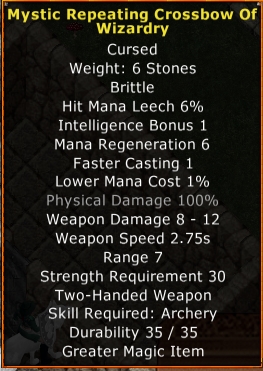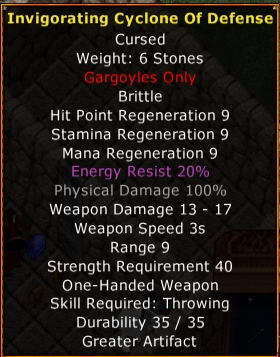Random Loot Generator
Return to: Shame Dungeon Re-vamp – A Guided Tour| Random Loot Generator |
| By Petra Fyde, November 2011 |
Taken from officially released information here and later amendments here with additional information discovered by players during testing.
Currently in use for Shame Dungeon and ‘lost and found’ items.
All items will have one of the following 8 designations near the bottom of the tool tip:
Minor Magic Item, Lesser Magic Item, Greater Magic Item, Major Magic Item, Lesser Artifact, Greater Artifact, Major Artifact, Legendary Artifact.
Lesser Artifacts are approximately equivelant to an item imbued to maximum weight.
Some items will have ‘grouped’ properties fitting a theme, these are named.
| Prefix | Suffix | Theme |
| Mighty | of Vitality | Strength and Hit point Related |
| Mystic | of Sorcery | Intelligence and Mana Related |
| Animated | of Haste | Dex, Stamina and Speed Related |
| Arcane | of Wizardry | Spell Casting Modifiers |
| Exquisite | of Quality | Item Quality/Durability |
| Vampiric | of the Vampire | Leeches and Drains |
| Invigorating | of Restoration | Regeneration (including damage eaters) |
| Fortified | of Defense | Damage Avoidance |
| Auspicious | of Fortune | Luck |
| Charmed | of Alchemy | Enhance Potions (including Balanced) |
| Vicious | of Slaughter | Dealing Damage (including Slayers) |
| Towering | of Aegis | Mitigating Damage Taken (including Resists) |
Items can be:
- unnamed, random properties
- prefix only (properties from one theme, some random)
- suffix only (properties from one theme, some random
- Prefix and suffix (properties from two different themes)
Examples:
Creature Strength
The strength of an item generated depends partially on the strength and toughness of the creature killed.
There is a very small chance that a loot drop will be a very powerful item. This can happen with weak creatures, but is extremely rare. This is more likely to happen with stronger creatures. Luck significantly increases the chance of this happening.
Item Strength
Weak items
- Typically: unnamed with 5 random properties at low values
- Occasionally: named with fewer than 5 properties, allowing for imbuing
- Usually: have no disadvantages
Strong items
- Typically: will have 5 item properties
- Frequently: will be named
- Usually: will have disadvantages
Extremely powerful items
- Sometimes: will have more than 5 properties.
- Usually: will have more disadvantages
Item Properties
- Luck only appears in increments of 10
- Skill bonuses only appear in increments of 5
- Property values can exceed existing caps
- Properties can appear on item types that don’t have that property (eg MR on jewellery)
- Some properties may be temporary, ie spell effects with a set number of ‘charges’
Disadvantages
These appear on items randomly, each disadvantage grants the item significantly more power, the most powerful items therefore have more disadvantages. Items that are free of disadvantages, ie ‘clean’ can be generated. Weak items are frequently ‘clean’, powerful items are very rarely ‘clean’. Luck has no influence on the frequency of item disadvantage generation.
- Unlucky – shows as ‘luck – 100′ in the tooltip. Power boost: small
- Brittle – Cannot use Powder of Fortification. Durability is 35 unless the item also has ‘can not be repaired’. If both properties are on the item durability is 75. Power boost: moderate
- Cannot Be Repaired – Cannot be repaired by any means, cannot use PoF. Durability 150 unless the item also has ‘brittle’ (see above). Power boost: High
- Cursed – Item cannot be insured or blessed. Power boost: Extreme
Unlucky and luck cannot appear on the same item. Self repair and Durability increase cannot appear on any item with brittle or cannot be repaired.
How it Works
Creatures are assigned a difficulty rating. When the creature is killed, its Difficulty Rating and the killers’ Luck factor into loot generation. More difficult creatures generate more items.
Generation, Step 1. The Item Budget
- Each item receives a base item property budget and a bonus item property budget
- The bonus property budget may be added multiple times. The higher the killer’s Luck, the higher the chance of multiple Bonus Budget
Generation, Step 2. The Final Budget
- The higher the Budget, the more Disadvantage Rolls are made for the item
- Each Disadvantage Roll has a chance of adding a new Disadvantage
- Each Disadvantage adds a fixed bonus to the item’s Budget
Generation, Step 3.
- The higher the final budget, the greater the chance of generating named items
- The higher the final budget, the more properties will be added
Finally, the budget is spent to add item properties to the item.
Last modified: November 16, 2011
















